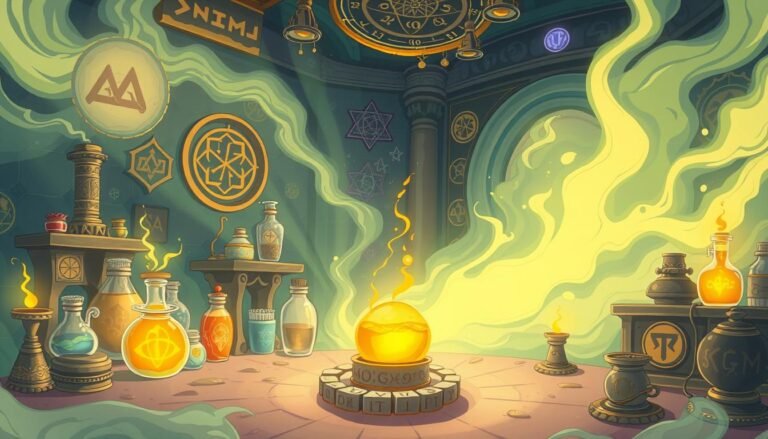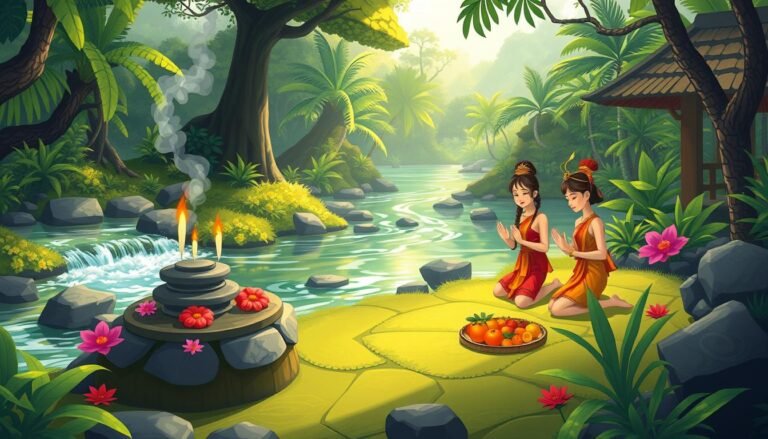How Can Taoist Philosophy Guide Us Toward Harmony?
“The journey of a thousand miles begins with a single step.” This wisdom from Lao Tzu shows the heart of Taoist philosophy. It tells us that finding harmony starts with small steps.
Taoism is a major ancient Chinese religion. It blends philosophy and religion in a unique way. It focuses on personal growth and inner strength.
The Tao, or “The Way,” is key in Taoism. It teaches us to live in harmony with nature. By being present and mindful, we can find balance in life.
In today’s fast world, Taoist teachings offer peace. They help us enjoy the moment and live a balanced life. Practices like meditation and qigong connect us with our inner selves and the universe.
Exploring Taoist philosophy, we find wisdom for life’s challenges. It leads to inner peace and harmony. Let’s start this enlightening journey together.
Understanding the Essence of Taoism
Taoism is a Chinese philosophy that teaches about harmony and balance. It started around 500 B.C.E. and is based on the teachings of Lao Tzu. The Tao Te Ching, with 81 poetic chapters, is at the heart of Taoist teachings.
The concept of Tao or The Way
The Tao, or “The Way,” is the guiding force of the universe. It teaches us to live in harmony with nature. This idea is central to Taoism, urging us to find balance in life.
Origins and historical context
Taoism became well-known in the eighth century C.E. during the Tang dynasty. Despite challenges during China’s Communist era, Taoism has seen a comeback. Today, Chinese leaders celebrate these traditions, blending them with modern socialism.
Key principles of Taoist philosophy
Taoism values simplicity, balance, and inner peace. The idea of wu wei, or “non-action,” promotes effortless living in harmony with nature. Chuang Tzu, another key figure, stressed spontaneity and rejecting strict rules.
“The Tao that can be told is not the eternal Tao.” – Lao Tzu
Today, Taoist practices like meditation and tai chi are loved worldwide. They offer a way to find peace in our busy lives. Taoism’s wisdom remains relevant, helping us deal with life’s challenges.
The Principle of Yin and Yang in Harmony
Yin yang is a key part of Chinese philosophy. It talks about balance and duality in nature and our lives. This idea has been around since the 14th century B.C.E., showing how different forces work together.
The words yin and yang started with “shady side” and “sunny side” of a hill. This simple idea grew into a deep philosophy about balance. Yin is about darkness, femininity, and calmness. Yang is about light, masculinity, and action.
In Taoist thinking, yin and yang are not enemies but parts of a whole. They find harmony by working together, as shown in the circular symbol. This idea shows up in many parts of life:
- Day and night
- Hot and cold
- Active and passive
- Male and female
The idea of yin yang teaches us to find balance. By seeing these forces together, we can become whole and flow. This idea helps in personal relationships, health, and solving problems every day.
“When people see things as beautiful, ugliness is created. When people see things as good, evil is created. Being and non-being produce each other.” – Lao Tzu
Knowing about yin yang helps us deal with life’s ups and downs better. It shows us that change is always happening and that opposites can come together. By accepting this, we can live a more balanced and happy life.
Wu Wei: The Art of Effortless Action
Wu Wei is a key idea in Taoist philosophy. It teaches us to move with life’s natural flow. This idea of effortless action means letting go of control and aligning with the universe’s rhythm. By embracing non-action, we can achieve more while doing less.
Letting Go of Control
Wu Wei invites us to release our grip on life. Instead of forcing outcomes, we learn to trust the process. This approach reduces stress and opens us to new possibilities. Like a leaf floating down a stream, we move with grace when we stop resisting the current.
Aligning with Life’s Flow
Practicing Wu Wei means tuning into life’s natural patterns. It’s about finding your groove and working with, not against, your circumstances. This mindset helps us navigate challenges with ease and find creative solutions effortlessly.
Wu Wei in Daily Life
Incorporating Wu Wei into your routine can transform your experience. Start small:
- Take a mindful pause before reacting
- Listen to your intuition
- Choose the path of least resistance
By practicing these simple steps, you’ll find yourself in a state of flow more often. You’ll accomplish tasks with less effort and more joy.
“Nature does not hurry, yet everything is accomplished.” – Lao Tzu
Remember, Wu Wei isn’t about inaction, but about acting in harmony with your true nature and the world around you. By embracing this principle, you can achieve more while struggling less. You’ll find a sense of peace in the process.
Embracing Simplicity and Minimalism

Taoism teaches us to find happiness in simplicity. It tells us to remove life’s clutter to focus on what’s important. This way, we make room for peace and clarity in our lives.
The Taoist way is about living in harmony with nature and avoiding unnecessary trouble. It matches well with today’s minimalism, which values real experiences over stuff. By following these ideas, we can find happiness and balance in our busy lives.
“Simplicity is the ultimate sophistication.” – Leonardo da Vinci
Here are some ways to add simplicity to your life:
- Practice mindfulness for 5-10 minutes each morning
- Reflect on daily activities to identify areas of complexity
- Embrace single-tasking for enhanced focus
- Take mindful breaks to prevent burnout
- Establish clear boundaries between work and personal time
By following these Taoist tips, we can live a more balanced and happy life. Simplicity and minimalism show us that happiness comes from enjoying the moment, not from always wanting more.
Taoist Philosophy and Harmony with Nature
Taoism teaches us to live in tune with nature. This ancient wisdom is more relevant today than ever. By observing natural cycles, we can understand life’s rhythms and apply them to our journey.
Learning from Nature’s Wisdom
Nature is our greatest teacher. The changing seasons, the ebb and flow of tides, and plant growth cycles all teach us valuable lessons. These cycles mirror our lives, showing us that change is constant and necessary for growth.
Deepening Our Environmental Connection
Taoism encourages a strong bond with nature. This connection fosters a sense of unity with the world. Simple activities like walking in a forest, gardening, or watching a sunset can strengthen this bond.
Applying Nature’s Lessons to Daily Life
We can use nature’s wisdom in our daily lives. Just as trees bend with the wind, we can learn to be flexible in facing challenges. Like a river finding its path, we can adapt to obstacles and flow around them. This approach helps us live more harmoniously and with less stress.
“Nature does not hurry, yet everything is accomplished.” – Lao Tzu
By embracing Taoist principles, we can cultivate a deeper respect for the environment and live more sustainably. This philosophy reminds us that we are part of nature, not separate from it. When we align with natural cycles, we find balance and peace in our lives.
Mindfulness and Meditation in Taoist Practice
Taoist meditation has deep roots in ancient Chinese wisdom. It started in the Warring States period (475–221 BCE). This time saw the rise of many philosophical schools, including Taoism.
Taoist spiritual practices include three main types of meditation: concentrative, insight, and visualization. These practices are key to Taoist mindfulness.
The Guanzi, a historical text, talks about meditation techniques like “Mind techniques” and “Purifying the mind.” These are the basics of Taoist mindfulness. The Neiye, another ancient text, highlights breath control as crucial for self-cultivation.
Maintain oneness and revolve qi.
This quote from Neiye Verse 24 shows the heart of Taoist meditation. It talks about unity and energy flow. Practitioners use nature as inspiration, seeing themselves as a stream or a mountain.
Qigong is a big part of Taoist practice. It mixes meditation, breathing, and gentle movements. It aims to improve both body and spirit. By matching breath with nature, practitioners feel connected to the world.
Taoist meditation also follows the idea of Wu Wei, or effortless action. This idea is about moving naturally and not holding onto thoughts. It leads to wisdom and peace.
- Focus on breath control
- Visualize natural elements
- Practice Wu Wei
- Cultivate inner energy (Qi)
These mindful practices help people become more aware and present. They connect with universal energy, bringing harmony to their lives and relationships.
The Three Treasures: Compassion, Moderation, and Humility
Taoist virtues guide us to live in harmony. The Three Treasures – compassion, moderation, and humility – are at the heart of Taoist wisdom. They help us face life’s challenges and find peace within.
Cultivating compassion for self and others
Compassion is key in Taoist philosophy. It means being kind to ourselves and others. In rural areas, people focus on the community’s needs over their own. This selfless love promotes respect for elders and care for the weak.
Practicing moderation in all aspects of life
Moderation, or frugality, is about using resources wisely. It’s not just about using less, but giving more. Jeff Bezos, Amazon’s founder, sees frugality as a way to be resourceful.
In a world where 33% of food is wasted, moderation leads to a balanced life. It helps us live sustainably.
Embracing humility as a path to inner peace
Humility teaches us our place in the world. It’s about letting go of ego and not thinking we’re better than others. Rural communities often show this virtue, seeing themselves as part of a larger community.
This humble approach brings peace and harmony in relationships.
“The three treasures – compassion, moderation, and humility – are the keys to living in harmony with the Tao.”
By embracing these Taoist virtues, we can find balance in our lives. These principles help us live in harmony, whether in cities or rural areas. They guide us to inner peace and connection with others.
Taoist Philosophy and Harmony in Relationships
Taoist philosophy brings a special way to make relationships better. It helps us find balance and enjoy our connections more. Research shows that 65% of people often feel like they’re not being heard. This shows we need better ways to talk to each other.
In Taoist relationships, yin and yang are key. This symbol, found in 80% of popular culture, teaches us about balance. Taoism teaches us to accept and understand others, rather than trying to change them.
“The wise man is one who knows what he does not know.” – Lao Tzu
Here are some Taoist ideas for better relationships:
- Practice active listening without judgment
- Embrace the natural flow of conversations
- Cultivate compassion for yourself and others
- Seek balance between giving and receiving
Using these ideas can make your relationships more harmonious. True balance comes from within. By following Taoist wisdom, you’ll find peace and understanding in your interactions.
Applying Taoist Principles to Modern Life Challenges
In today’s fast world, Taoism brings a fresh view on life’s problems. This ancient wisdom, over 5,000 years old, helps us manage stress and find balance. It’s all about living in harmony with life.
Navigating stress and uncertainty
The idea of Wu Wei, or “non-action,” teaches us to go with life’s flow. It helps us accept change and find peace. Taoism says we’re all connected, urging us to bond with our surroundings and ourselves.
Finding balance in a fast-paced world
Taoism values simplicity and happiness for a peaceful life. We can simplify our lives by clearing out clutter. The Yin and Yang remind us to balance work, rest, and fun.
Cultivating resilience through Taoist wisdom
The Tao Te Ching, Taoism’s core text, focuses on self-discovery and growth. Understanding ourselves builds strength. Taoist teachings lead us to well-being and harmony, helping us face life’s ups and downs with ease.
Source Links
- Taoist Philosophy
- Taoist Philosophy and the Art of Living: Key Concepts and Practices
- Taoism
- Taoism: The Ancient Path to Harmony and Balance
- Yinyang (Yin-yang) | Internet Encyclopedia of Philosophy
- Yin and yang
- Wu Wei: The Art of Effortless Action | Stephan Joppich
- Wu wei
- Wu Wei Meaning: the Philosophy of Effortless Action
- The Art of Simplicity: Tao Te Ching’s Impact on Daily Productivity
- How Taoism Provides a Framework For Living a Virtuous Life
- The Role of Nature in Taoism: Find Harmony & Balance
- Taoism emphasizes harmony between humanity and nature
- A Journey to Inner Harmony – Tea, Qi, and Taoist Philosophy – Hence Tea
- Taoist meditation
- Guided Meditation in Taoism and Buddhism ; Which is Better ?
- Harmony in Action: Applying Taoist Principles in Team Dynamics
- The 3 jewels of Taoism are helping drive the Rural Renaissance
- The Three Treasures of Daoism
- The Three Jewels Of The Tao: Embracing The Way Of Water – The Mindful Stoic
- Taoism In Relationships — Adam G. Walterbach, LCSW
- Taoism: 6 Key Concepts From The Ancient Philosophy of Daoism
- Taoist philosophy
- Taoism: Its Relevance and Application in Everyday Life
- Taoism – Ancient Wisdom for a Modern World: The Tao of Daily Living








